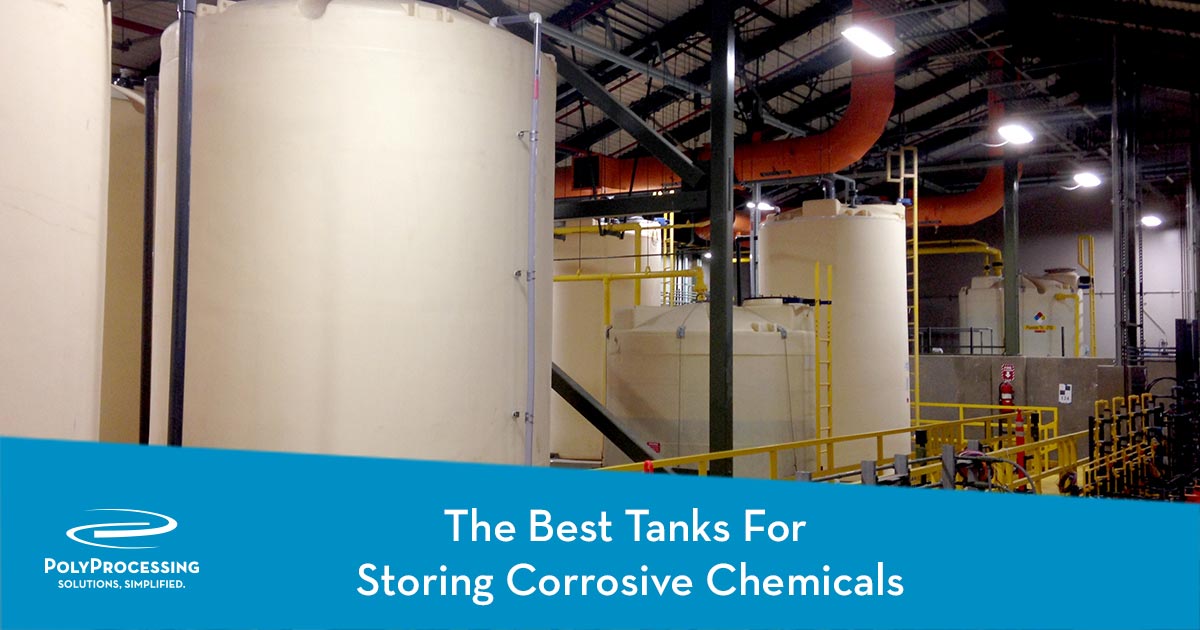The Best Tanks For Storing Corrosive Chemicals
Whether you’re an engineer writing a spec for a chemical storage system, or an end-user who is looking for the best way to store corrosive chemicals, there are multiple factors that go into creating a safe storage system. Cost might be your first consideration, but there is more to consider than the initial price of the tank, its fittings and accessories, delivery, installation, and tank longevity.

It’s important to consider the durability and longevity of the tank system when you’re storing corrosive chemicals. In fact, every good tank design starts by considering the chemical you’re storing. Everything else flows out of that. Leaks and degradation can be costly to repair—and even more costly when a tank system has to be replaced because it wasn’t engineered to store your corrosive materials.
Let’s take a look at the nature of corrosive chemicals and the chemical storage industry’s best tank options to help you make the right storage tank decision.
What Chemicals Are Corrosive?
A corrosive chemical is one that will damage or destroy another substance upon contact. In most cases, the higher the concentration, the more corrosive it is. It can cause chemical burns to live tissue, and the chemical fumes can cause eye and lung irritation or damage. Both acids and bases can be corrosive.
Some commonly stored corrosive chemicals include:
Many of these chemicals can corrode metal, especially at higher temperatures. When metals corrode because of these substances, they give off a hydrogen gas, which is flammable.
If you are storing your chemicals in a plastic tank, there is no metal to corrode and you are protected from these hazardous fumes. That is why polyethylene is the preferable tank material for storing these types of chemicals.
Not All Polyethylene Tanks Are Created Equal
Polyethylene is a durable plastic that’s available in medium-density, high-density (HDPE) and high-density cross-linked (XLPE) forms. Medium- and high-density polyethylenes are usually linear, which means that the polymers of the plastic are joined in a twisted formation like rope fibers, rather than knotted in nature.
XLPE is created in a way that the very molecules of the plastic are bonded and linked, creating a superior product that has much greater impact and tensile strength of linear polyethylene. Imagine a chain-link fence where the metal is actually linked together. The chemical resistance, heat resistance, and dimensional stability are unparalleled.
Crosslinked polyethylene has covalent bonds that connect its polymer chains. These bonds tie the polymers together and lengthen the polymer chains, giving the polyethylene stronger resistance to corrosive materials. The molecular structure provides superior stress cracking resistance, improved toughness and much greater useful life compared to linear polyethylene.
Extend Your Tank’s Resistance to Corrosion
To extend the longevity of your cross-linked polyethylene tank, you can store corrosive oxidizing chemicals in an XLPE tank with an anti-oxidant barrier system. The technology behind Poly Processing’s OR-1000™ takes the guesswork out of choosing the right storage tank system for oxidizing chemicals.
We use antioxidant additives to extend tank life. This fights off corrosion caused by oxidizing chemicals, regardless of the type of plastic. Antioxidants extend the longevity of HDPE, XLPE, nylon, and any other plastic since they are all carbon-based. Oxidation slowly deteriorates any carbon-based bond, whether it’s in a plastic, plant, or animal.
The OR-1000 is a resin system made of polyethylene, but what makes it special is the 400 percent more antioxidant additives in that resin. OR-1000 is added to your chemical tank during the rotomolding process, which creates a seamless bond between the barrier resin and the XLPE polyethylene. The result is a stronger, more durable tank system that doesn’t have the risks and maintenance costs of an FRP tank or a mass-produced polyethylene tank with a potentially faulty lining.
This unique combination of polyethylenes creates an ideal containment for even the most corrosive chemicals:
- XLPE gives you the strength and tank longevity.
- OR-1000 gives you optional additive oxidation resistance over time.
The value, longevity, strength, and durability of an offering like OR-1000 with XLPE can stand up to almost any chemical and stand the test of time.
Talk to a chemical storage expert today to prepare the best storage system for your corrosive chemicals
- May 11, 2020
- Topics: Chemicals, Tank Design and Materials
About Poly Processing
Posts By Topic
Tech Talk Podcast Episodes
Subscribe By Email
Recent Posts
- Installation Tips for Chemical Storage Tanks: Site Preparation and Offloading
- Understanding pH and Chemical Concentration When Choosing a Chemical Tank
- Maximizing Fill Efficiency: Selecting the Optimal Fill Line System
- Chemical Storage Tanks: A Quick Guide for End Users
- Popular Customization Options for Chemical Storage Tanks
Tank Configurator

Find the recommended tank and system components for your chemical storage challenge.
Configure a Tank Package




